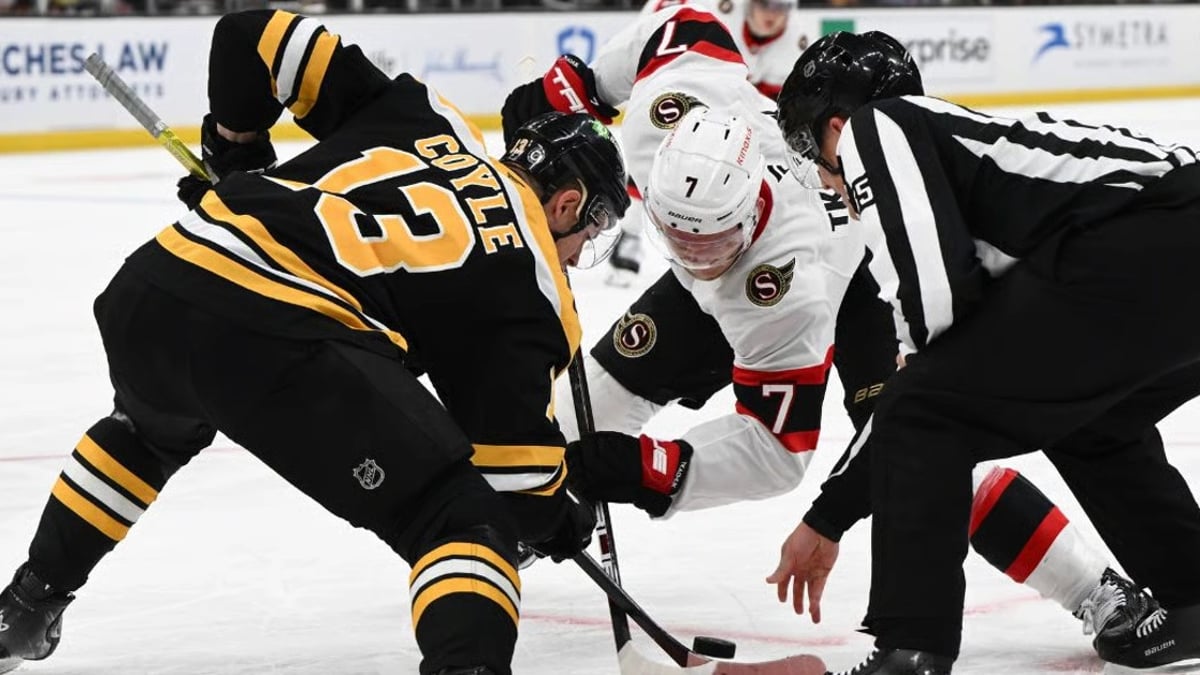What is a Puck Line? Puck Line Bets Explained

- #ad. 18+. Gamble Responsibly. Gambleaware.org. Must be 21+ and present in OH. Gambling Problem? Call 1-800-GAMBLER
Welcome to Puck Lines 101, where we’ll take you through everything you need to know about one of the most popular betting markets for the coolest game on ice.
NHL puck lines are similar to point spreads in football or run lines in baseball; they indicate the projected margin of victory in an NHL game.
Note: This guide refers to the National Hockey League—North America’s top professional ice hockey league. Odds are listed in American format (e.g., +150), but your betting sites may display decimal (2.50) or fractional (6/4) odds instead. Most platforms allow you to toggle your preferred format.
Introduction to Puck Line Betting
Like run lines, puck lines are usually fixed at -1.5 for the favorite and +1.5 for the underdog. This makes sense, as one or two goals decide most games.
In the simplest terms, if you take a team at -1.5, they’ll need to win by two or more for your bet to cash, and if you take a team +1.5, they’ll need to stay within a goal for you to walk away a winner. Puck lines are a popular betting option, as they give you a little cushion when you back a ‘dog and better odds when you’re putting your money behind the favorite.
How Puck Line Betting Works
This is true of most (but not all) puck line bets:
- The favored team is given a -1.5 goal handicap.
- The underdog is given a +1.5 goal advantage.
Overtime Rules for Puck Line Betting
Ah, overtime. The best friend of anyone who took the underdog with a puck line bet … and the death knell for any wager on the favored side of a puck line bet.
When an NHL game gets to overtime, the first team to score wins, or if the game is tied after OT, the shootout winner gets credit for an extra “goal.” In either case, only one more tally is on the score sheet.
So if a game is tied after regulation, all +1.5 bets are guaranteed to hit, and all -1.5 bets cannot possibly win.
You must carefully read the terms and conditions of your preferred NHL betting sites to see how they will honor overtime goals in puck line payouts.
What it Means When Puck Lines Move to -2.5/+2.5
Occasionally, if there’s a big talent gap or disparity in the two teams' records, the puck line will move by a goal in either direction.
These puck lines work the same as -1.5/+1.5 bets, but the game will need to be more of a blowout for the favorite to win and only somewhat competitive for the underdog to cover. (Note that we’ll cover alternate puck lines, which some online betting sites offer, later in the article.)
How to Read Puck Lines Odds
While the goal differentials may be fixed at plus or minus 1.5, you’ll see a wide spread of odds for either side of a puck line bet. You could see a team at -1.5 or +1.5 with either positive or negative odds, depending on the matchup and the relative talent of the teams involved.
Like moneyline bets, bettors will see that the odds for puck lines are set according to the relative quality of the two teams facing off.
Yes, puck lines do quite a bit to equalize the odds, driving them towards even. But, in the eyes of the bookmakers, rarely will a team be exactly 1.5 goals better or worse than another team. (And there’s always the vig taking a bite of the apple, too.)
Here are a few of the most frequent scenarios to illustrate how the math can work:
Example 1: Fairly Even Matchup Between Favorite & Underdog
Moneyline Close to Even:
- Favorite -1.5: +190
- Underdog +1.5: -210
In this case, one team has to be the puck line favorite, but that team will have significant positive odds. On the other hand, the team getting 1.5 goals will have fairly significant negative odds.
Example 2: One Team is Clearly Favored Over the Other
Moneylines Are Widely Spread:
- Favorite -1.5: -110
- Underdog +1.5: -115
In cases like this, the handicap has equalized the odds, and the payout will be similar on both sides of the matchup. This doesn’t mean you won’t see adjustments one way or the other based on how money is flowing, injury news, or even roster shakeups. -130/+110, -125/+110, and -120/+100 would all be very reasonable puck lines—even if one team has a much better record.
Example 3: One Team is Favored, But Not by a Large Margin
Moneylines Are Spread, But Not Drastically:
- Favorite -1.5: +140
- Underdog +1.5: -165
Here, the puck line has essentially flipped the moneyline odds. The favored team isn’t considered enough of a favorite to make up for giving 1.5 goals, and the underdog is considered “too good” to be getting 1.5 goals at close to even odds.
The result? A plus line for the favorite and negative odds for the ‘dog.
So, to summarize, puck lines do “level” the ice and the odds, but not as precisely as you might think. That’s why you’ll see a wide range of odds, despite that standard margin of 1.5.
Variations of Puck Line Betting
Alternative Lines
Just like most betting sites allow bettors to move the line one way or the other for football or basketball (often with a slider that shows how the odds will change), you can also pick a hockey team to win by a greater margin or give a team more of a cushion in terms of keeping it close.
Alternate puck lines let you change the standard 1.5 goal spread to 2.5, 3.5, or, in some cases, 4.5 or higher (though you won’t see lines higher than that very often). The main idea is the same as it is for standard puck lines, but of course, the favorite needs to win by a larger margin, and the underdog only has to keep the game as close as the handicap dictates.
Sometimes, you can pick an underdog to win by 1.5 or more goals with alternate lines, resulting in big odds swings in the positive direction. Conversely, if you want to give the favorite extra goals, you’ll be looking at very short odds and a very low payout.
An important thing to remember is that the further away from the main puck line you are, the more drastic the changes to the odds will be.
3-Way Puck Lines
3-way puck lines can be a bit tricky. Unlike standard puck lines, 3-way bets include the tie as a betting option, decided only by regulation-time score.
One of the most important things to remember is that 3-way puck lines do not include overtime or shootouts. Instead, they include ties as one of three possible outcomes, and the bet will be decided at the end of regulation, one way or the other. The three betting options for this market are the favorite at -1, the underdog at +1, or the tie.
For the tie to win, the score must be tied after the third period. (As noted, what happens in overtime does not matter.) The underdog bet cashes if the team wins the game in regulation, OR if the score is tied after the third period. The underdog bet pushes if the team loses by exactly 1 goal. At -1, the favorite must win the game by two or more goals to make for a winning bet. The favorite bet pushes if the team wins by exactly one goal.
These bets are generally not a standard hockey betting market. However, some betting sites call this bet type the 60-minute line or 3-Way result.
The main difference is that these bets don’t involve a puck line. You’re betting on one team to win or for the game to be tied at the end of regulation.
Strategies for Betting the Puck Line
As with many hockey betting markets, there are many things to consider when putting your money down.
Here are some of the variables that can make a big difference in a puck line bet going one way or the other:
Track Team Tendencies
Whether you’re leaning toward a favorite or backing an underdog, it’s important to consider the team's style and strategy.
If a team pours it on offensively and plays even better with a lead, you might bet on them to win by multiple goals and take the line at -1.5. If a big underdog always seems to rise to the occasion against top teams, picking them to stay within a couple of tallies could be a strong position. If a particular team matches up well or poorly against another squad, that might influence your decision, too.Monitor Lineups/Roster Status
It’s important to remember that the NHL season is a marathon, not a sprint. Teams may shuffle lineups, rest key players, or decide to start the backup goalie on the second night of a back-to-back.
Before placing a puck line bet, you should see if the lineups for the game have been released, or at the very least, see if there are any major injuries, transactions, or other roster shakeups to consider.Pay Attention to Standings
At some point in the season, especially as the campaign winds down, teams may be in different positions with different goals. A team battling for a playoff spot will likely put its best lineup out there and play hungry. On the other hand, a team that clinched the No. 1 seed and home ice in the playoffs might give some players lower on the roster a chance to get more playing time and not have quite the same fire for the full 60 minutes.
Don't Forget Empty-Net Goals
Finally, we’d be remiss if we didn’t mention one of (what we consider) the most exciting and score-changing plays in hockey: the empty netter. Hockey fans and bettors know that a team losing at the end of regulation will pull the goalie with a minute or two left to put another offensive player on the ice. It’s a sound strategy, but it can drastically change your chances of hitting a puck line bet.
Most of the time, the team in the lead will score an “extra” goal via an empty-net goal. If you follow a team, you may know roughly how often they convert with no one guarding the pipes. You can also look up this data. Either way, it’s good to be aware that a 1-goal lead or deficit can easily turn into two or more during the final minutes of a game.
Final Thoughts on Puck Line Bets
Puck line betting is one of the most popular NHL markets, and you can find puck lines at every major betting site, including in-game lines that change almost from shift to shift.
As we mentioned, it can be a great equalizer for teams far apart in talent (and the standings) or a great way to shift the odds you get for an evenly matched tilt. Alternate puck lines are intriguing if you think a favorite will win handily, or a handy parlay piece (or conservative straight bet) if you want a multi-goal cushion for the side you’re picking.
However, you use NHL puck lines, we hope you’ve got a better idea of how they work, what can shift the odds, and what factors you might want to consider when playing them.
As always, bet responsibly, play within your limits, and have fun.














